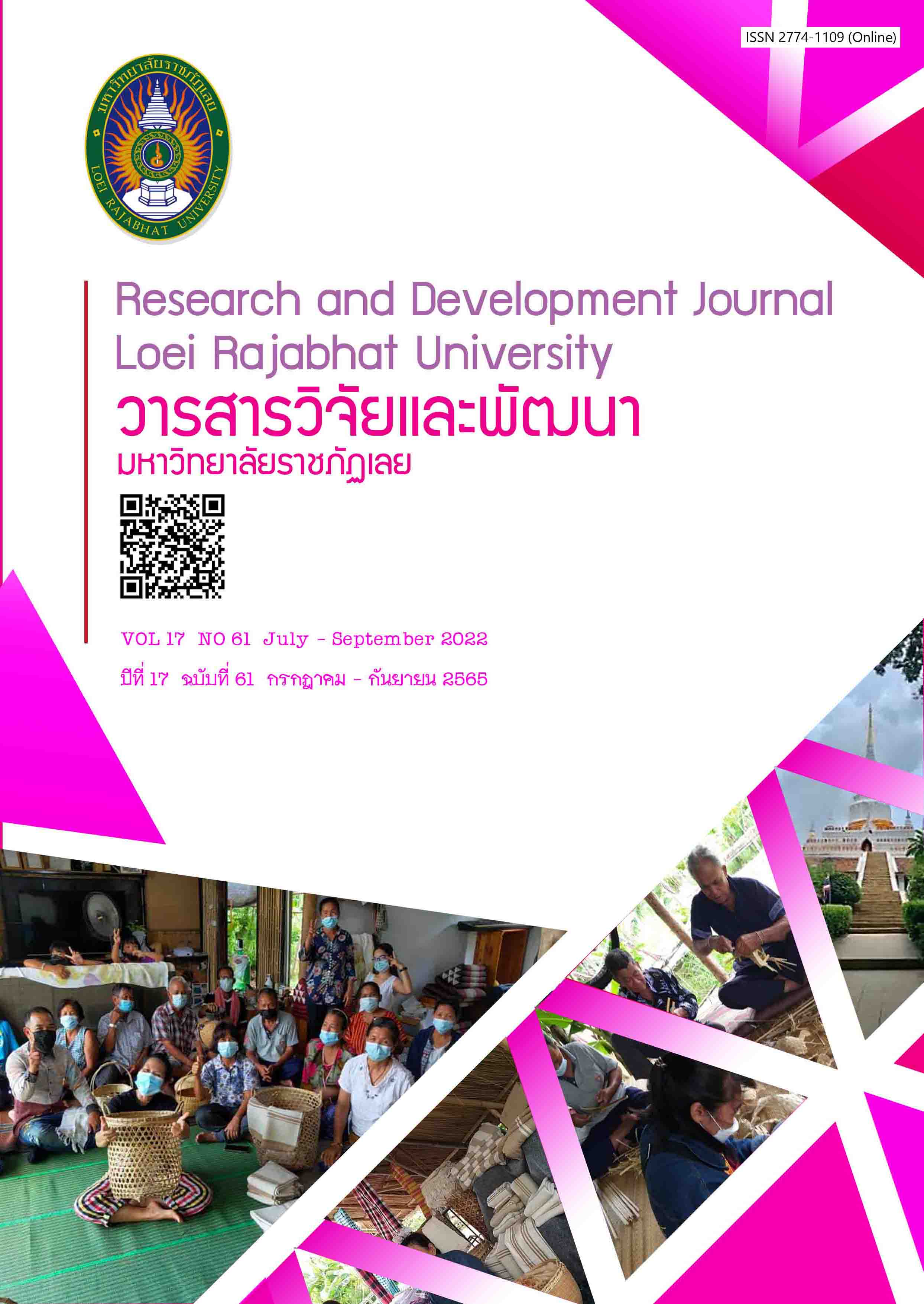Cultural Conservation Patterns Ban Nong Bua, Phu Luang District, Loei Province for Sustainable Tourism Management: Folk Arts and Crafts
Keywords:
cultural preservation, sustainable tourism management, folk arts and craftsAbstract
This academic article aimed to: 1) study the state of the area and culture of Ban Nong Bua, Phu Luang district, Loei province; and 2) study the model of cultural conservation of Ban Nong Bua, Phu Luang district, Loei Province. The data was collected 20 informants who were local wisdom scholars, community leaders, tourism management groups, and local academics using focus group conversation, interview and documentary review. Content analysis was implemented for data analysis. The results of the study were as follows.
1. Ban Nong Bua is a village in Phu Luang District, Loei Province. There are prehistoric archeological sites. The surrounding environment is plentiful; there are forests, mountains and rivers. There is also the legend and belief related to Phaya Chang and Nang Pom Hom (King Elephant and the Fragrant-hair Lady) of the people residing in the community and neighboring areas. The worshipping events are annually held. The cultures remained existent and held in the community are related to the 12-month rituals regarding to the beliefs of the community and Buddhism. In addition, the cultures related to handicrafts needed to be inherited and conserved were Saw Ka Bang, Bamboo Tung, crafts, pottery, and colored stones and terracotta accessories.
2. There are 8 models of cultural conservations: 1) the model of production and conservation group establishment; 2) the model of school curriculum management system; 3) the model of workshop training for community; 4) the model of training to promote understanding; 5) the model of community radio station; 6) the model of creating document in form of printings and online media; 7) the model of the Youth Group; and 8) the model source of learning conservation.
References
กุสุมา บุญกาญจน์ และ ชูวิทย์ สุจฉายา. (2558). การจัดทำแนวทางอนุรักษ์และฟื้นฟูชุมชนดั้งเดิมด้วย กระบวนการมีส่วนร่วมกรณีศึกษาชุมชนริมน้ำจันทบูร. วารสารวิชาการคณะสถาปัตยกรรมศาสตร์, 14(1), 59-82.
ปรีดา พูลสิน. (2555). การมีส่วนร่วมของชุมชนในการจัดการความรู้ทางศิลปวัฒนธรรม: กรณีศึกษาชุมชนวัดโสมนัส. วารสารวิจัยและพัฒนา, 4, 60-66.
พลอยภัทรา ตระกูลทองเจริญ. (2557). การศึกษาความตระหนักในการอนุรักษ์มรดกทางวัฒนธรรมผ่านกระบวนการการมีส่วนร่วมกรณีศึกษา: หมู่บ้านศาลาแดงเหนือ เชียงรากน้อย (วิทยานิพนธ์ปริญญาสถาปัตยกรรมศาสตรมหาบัณฑิต). มหาวิทยาลัยกรุงเทพ, กรุงเทพฯ.
พิทยวัฒน์ พันธะศรี. (2557). ซอบั้ง: การสืบทอดวัฒนธรรมการประดิษฐ์และการบรรเลงของชาวบ้านบ่อแก้ว ตำบลบ่อแก้ว อำเภอนาคู จังหวัดกาฬสินธุ์. วารสารวิชาการแพรวากาฬสินธุ์ มหาวิทยาลัยราชภัฏกาฬสินธุ์, 1(3), 9-25.
ศิริพงศ์ อริยสุนทร. (2558). การอนุรักษ์หรือฟื้นฟูจารีตประเพณี ภูมิปัญญาท้องถิ่น ศิลปวัฒนธรรมอันดีงามของท้องถิ่นและชาติตามกฎหมายว่าด้วยวัฒนธรรม: กรณีศึกษาการจัดตั้ง สภาวัฒนธรรมตามพระราชบัญญัติวัฒนธรรมแห่งชาติ พ.ศ. 2554 (วิทยานิพนธ์ปริญญารัฐศาสตร์มหาบัณฑิต). มหาวิทยาลัยธรรมศาสตร์, กรุงเทพฯ.
สุพัตรา คงขำ และ เครือวัลย์ คงขำ. (2561). แนวทางการอนุรักษ์ภูมิปัญญาพื้นบ้านการชักแห่เรือพระบกของตำบลเขาใหญ่ อำเภออ่าวลึก จังหวัดกระบี่. วารสารวิจัย มหาวิทยาลัยเทคโนโลยีราชมงคลศรีวิชัย, 10(2), 277-288.
หน่วยอนุรักษ์ทางศิลปกรรมและสิ่งแวดล้อม. (2563, 5 มิถุนายน). แนวทางและประโยชน์ที่ได้จากการอนุรักษ์ศิลปกรรมและสิ่งแวดล้อม. สืบค้นจาก http://culturalenvi.onep.go.th.
อารีรัตน์ พุฒิรุ่งโรจน์. (2557). แนวทางการส่งเสริมการอนุรักษ์และสืบทอดภูมิปัญญาว่าวไทย. วารสารวิทยบริการ มหาวิทยาลัยสงขลานครินทร์, 25(2), 37-46.
Downloads
Published
How to Cite
Issue
Section
License
Copyright (c) 2022 Research and Development Journal, Loei Rajabhat University

This work is licensed under a Creative Commons Attribution-NonCommercial-NoDerivatives 4.0 International License.
ข้อความที่ปรากฎในวารสารฉบับนี้เป็นความคิดเห็นของผู้เขียนแต่ละท่าน สถาบันวิจัยและพัฒนา มหาวิทยาลัยราชภัฏเลย และกองบรรณาธิการ ไม่จำเป็นต้องเห็นด้วยและไม่มีส่วนรับผิดชอบใดๆ
สถาบันวิจัยและพัฒนา มหาวิทยาลัยราชภัฏเลย ขอให้ผู้อ่านอ้างอิงในกรณีที่ท่านคัดลอกเนื้อหาบทความในวารสารฉบับนี้






